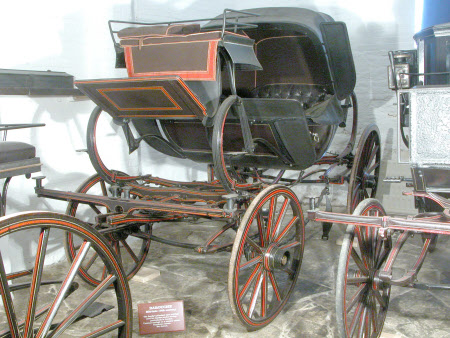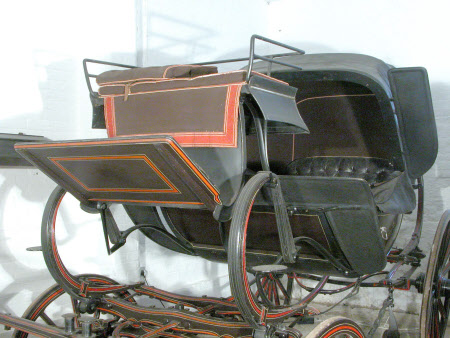Barouche
Griffiths of London
Category
Carriages & other vehicles
Date
1830 - 1900
Materials
Painted wood body with leather hood, wool cloth and morocco leather upholstery and four iron shod wheels.
Measurements
382.5 x 184 x 233.5cm (12ft 61/2in x 6ft 01/2in x 7ft 8in)
Place of origin
London
Order this imageCollection
Charlecote Park, Warwickshire
NT 534201
Caption
The barouche was a carriage for the very wealthy. Being a substantial in size it would have required a team of four large impressive horses to pull it. This carriage would have turned heads in the park. The barouche is a carriage for summer use only as it is not completely enclosed. The leather hood could be pushed right back allowing the carriage to be completely open. This particular barouche was built by the highly regarded Griffiths of London who were in business in Charles Mews, Westbourne Terrace from the 1850's until the turn of the century. It is painted maroon with the interior being upholstered in morocco leather.
Summary
Park Barouche built by Griffiths of London for the Lucy family circa 1860. Barouche (four wheels) for a team of horses. The body is sprung on C and under springs so that the it is symmetrical in profile. The interior is upholstered in deep buttoned black morocco. Body panels, wheels and carriage painted maroon with very broad black line centred with a broad red line edged with white lines. The Lucy Crest is on the doors.
Full description
A Barouche is a luxury carriage for taking drives around the park in during the summer. Due to their size they required four horses to pull them and so were expensive to keep, only the very wealthy could afford to own a barouche. This is a beautiful and very elegant, high park barouche on C and under springs, suspended so high that the body is symmetrical in profile. No step piece is needed to enable the body to clear the front wheels. The front body loops are extended to support the frame of the coachman’s seat and footboard, which are also supported by branched stays from the front of the body. The coachman’s seat has two leather-served seat rails and a beautifully worked splayed leather valance. The body is a very shallow canoe shape, so shallow that it could practically be described as saucer shaped. It has the usual barouche arrangement of principal seat facing forward protected by the head, and occasional seat beneath the leather-covered knee flap, which can be raised to form its seat back. A leather apron is attached to the back edge of the knee flap and is stretched to hooks on the inside of the head frame. Griffiths of London were in business in Charles Mews, Westbourne Terrace from the 1850's until the turn of the century.
Provenance
Given to the National Trust in 1945.
Marks and inscriptions
On nearside door panel. : Crest On offside door panels.: Crest On front nearside axle cap.: GRIFFITHS LONDON On front offside axle cap.: GRIFFITHS LONDON On rear nearside axle cap.: GRIFFITHS LONDON On rear offside axle cap.: GRIFFITHS LONDON
Makers and roles
Griffiths of London, coach builder
References
Carriage Driving, April-May 1997, pp.44-45

